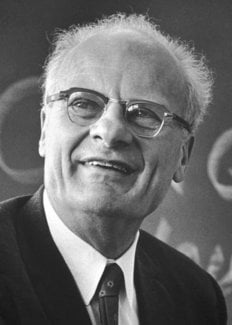Hans Bethe
Biographical

Hans Albrecht Bethe was born in Strasbourg, Alsace-Lorraine, on July 2 1906. He attended the Gymnasium in Frankfurt from 1915 to 1924. He then studied at the University of Frankfurt for two years, and at Munich for two and one half years, taking his Ph. D. in theoretical physics with Professor Arnold Sommerfeld in July 1928.
He then was an Instructor in physics at Frankfurt and at Stuttgart for one semester each. From fall 1929 to fall 1933 his headquarters were the University of Munich where he became Privatdozent in May 1930. During this time he had a travel fellowship of the International Education Board to go to Cambridge, England, in the fall of 1930, and to Rome in the spring terms of 1931 and 1932. In the winter semester of 1932-1933,he held a position as Acting Assistant Professor at the University of Tubingen which he lost due to the advent of the Nazi regime in Germany.
Bethe emigrated to England in October 1933 where he held a temporary position as Lecturer at the University of Manchester for the year 1933-1934, and a fellowship at the University of Bristol in the fall of 1934. In February 1935 he was appointed Assistant Professor at Cornell University, Ithaca, N. Y. U.S.A., then promoted to Professor in the summer of 1937. He has stayed there ever since, except for sabbatical leaves and for an absence during World War II. His war work took him first to the Radiation Laboratory at the Massachusetts Institute of Technology, working on microwave radar, and then to the Los Alamos Scientific Laboratory which was engaged in assembling the first atomic bomb. He returned to Los Alamos for half a year in 1952. Two of his sabbatical leaves were spent at Columbia University, one at the University of Cambridge, and one at CERN and Copenhagen.
Bethe’s main work is concerned with the theory of atomic nuclei. Together with Peierls, he developed a theory of the deuteron in 1934 which he extended in 1949. He resolved some contradictions in the nuclear mass scale in 1935. He studied the theory of nuclear reactions in 1935-1938, predicting many reaction cross sections. In connection with this work, he developed Bohr’s theory of the compound nucleus in a more quantitative fashion. This work and also the existing knowledge on nuclear theory and experimental results, was summarized in three articles in the Reviews of Modern Physics which for many years served as a textbook for nuclear physicists.
His work on nuclear reactions led Bethe to the discovery of the reactions which supply the energy in the stars. The most important nuclear reaction in the brilliant stars is the carbon-nitrogen cycle, while the sun and fainter stars use mostly the proton-proton reaction. Bethe’s main achievement in this connection was the exclusion of other possible nuclear reactions. The Nobel Prize was given for this work, as well as his work on nuclear reactions in general.
In 1955 Bethe returned to the theory of nuclei, emphasizing a different phase. He has worked since then on the theory of nuclear matter whose aim it is to explain the properties of atomic nuclei in terms of the forces acting between nucleons.
Before his work on nuclear physics, Bethe’s main attention was given to atomic physics and collision theory. On the former subject, he wrote a review article in Handbuch der Physik in which he filled in the gaps of the existing knowledge, and which is still up-to-date. In collision theory, he developed a simple and powerful theory of inelastic collisions between fast particles and atoms which he has used to determine the stopping power of matter for fast charged particles, thus providing a tool to nuclear physicists. Turning to more energetic collisions, he calculated with Heitler the bremsstrahlung emitted by relativistic electrons, and the production of electron pairs by high energy gamma rays.
Bethe also did some work on solid-state theory. He discussed the splitting of atomic energy levels when an atom is inserted into a crystal, he did some work on the theory of metals, and especially he developed a theory of the order and disorder in alloys.
In 1947, Bethe was the first to explain the Lamb-shift in the hydrogen spectrum, and he thus laid the foundation for the modern development of quantum electrodynamics. Later on, he worked with a large number of collaborators on the scattering of pi mesons and on their production by electromagnetic radiation.
Bethe is married to the daughter of P.P. Ewald, the well-known X-ray physicist. They have two children, Henry and Monica.
This autobiography/biography was written at the time of the award and first published in the book series Les Prix Nobel. It was later edited and republished in Nobel Lectures. To cite this document, always state the source as shown above.
Hans Bethe died on March 6, 2005.
Nobel Prizes and laureates
Six prizes were awarded for achievements that have conferred the greatest benefit to humankind. The 14 laureates' work and discoveries range from quantum tunnelling to promoting democratic rights.
See them all presented here.
